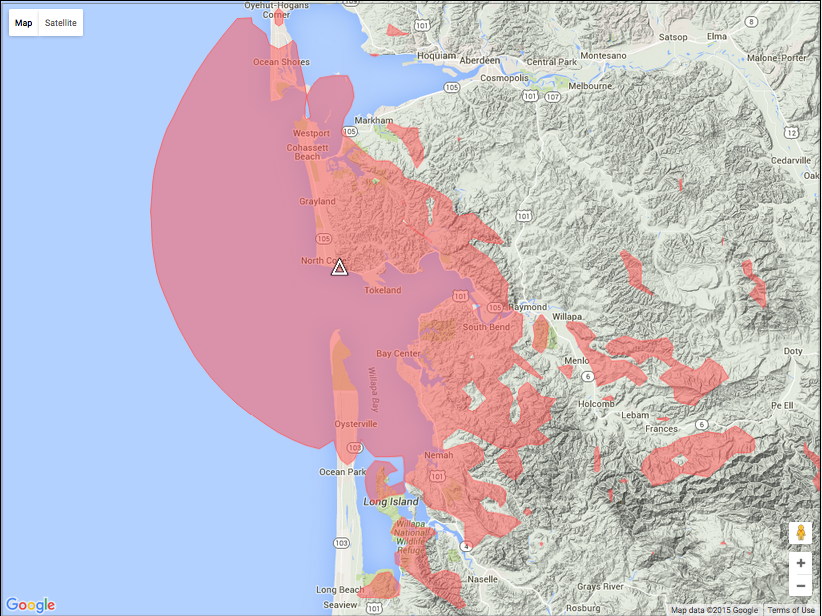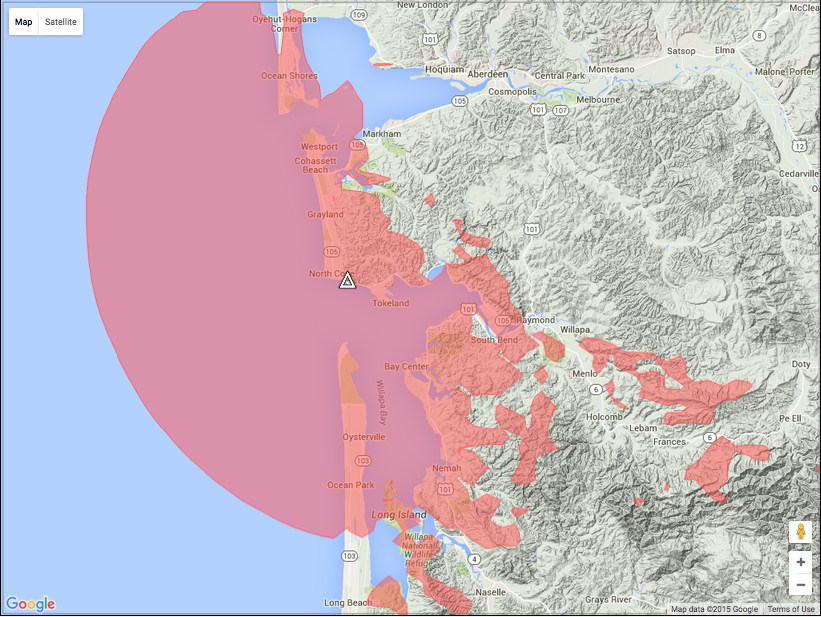North Cove
Pacific County, WA
46.734566, -124.047403
550 Feet
Call: NM7R
145.310 -600kHz 118.8Hz
444.400 +5MHz 118.8Hz

North Cove VHF Repeater

North Cove UHF Repeater
The North Cove repeaters
were both refurbished and
returned to service, August
of 2015 with upgraded
antenna, feedline, chassis,
RF decks and linking radios.
|
Location: The North Cove site is
on the ocean bluff,
overlooking North Cove, near
Tokeland/Grayland, WA, above "Washaway Beach" on the north side of
the mouth of Willapa Bay. The tower is visible on the headlands
driving south-east bound on Highway 105, after making the turn to the east,
about 3 or 4 miles west of the Tokeland turnoff.
Coverage: The two North Cove repeaters can be easily
accessed north along State Route 105 to
Westport, WA, and south along the ocean side of the Long
Beach Peninsula, especially the beach area.
Looking due south from
the repeater site, the tip of the Long Beach Peninsula
is only six miles away, with the repeaters looking down the
beach. The Surfside community is only 12 to 14 miles away.
The coverage
to the east overlaps with that from the South Bend, Naselle and Megler
repeaters. The North Cove repeaters can be particularly useful along
Highway 101 while driving the eastern shore of Willapa Bay,
especially the VHF repeater. The over-water path to
most of Highway 101, from South Bend (Milepost 53) to
the Bear River area (Milepost 20) provides nearly spotless coverage.
The one place that might be a little
problematic is between Milepost 28 and
Milepost 34 (the so called "Nemah" area), where the highway dives into the woods. To cover this
particular area, we have installed a
remote receiver at the Naselle site
for use with the 145.310 VHF repeater, providing very good coverage
in this area, and usable from Bay
Center (Milepost 40), south along Highway
101 to the Highway 4 junction at "Johnson's Landing", and
for a few miles east or west from there.
To use this high-altitude receiver, shift your CTCSS (PL) tone
from the usual 118.8 Hz to 114.8 Hz and your transmissions
will be picked up loud and clear in this area.
The 444.400 UHF repeater
works well along Highway 101,
south of South Bend, between
Milepost 55 and Milepost 22.
Linking: The 2-meter repeater
is normally linked to
BeachNet,
and like all of our repeaters, the link can be dropped to make this
repeater stand-alone when that is desirable.
The 70-centimeter repeater
may be linked to
BeachNet,
but often is operated either stand-alone or linked to the IRLP net,
as a local option.
When the 444.400 MHz North Cove repeater is
linked to the IRLP Net, an
independent Internet-linked system, one will usually hear
out-of-area stations conversing. You are free to join
the conversation.
If you are
traveling
on Highway 101,
between Milepost 55 (in the South Bend area), and
Milepost 22
(the Willapa National Wildlife Refuge Headquarters)
consider switching to the
444.400 MHz North Cove repeater.
Once south of Milepost 22, or after turning onto Highway 4,
the Megler IRLP
444.925 (82.5 PL) repeater
covers south into
Oregon to well south of Seaside.
IRLP is an exciting way of bringing the flexibility of the internet
to repeater linking, allowing repeaters from all over the world to be
networked together.
More information here.
Hardware: The
VHF
repeater consists
of a GE
Mastr-II station
with PLL Exciter, and factory option UHS receiver preamp.
The CAT-200B controller is housed inside the
repeater chassis, on the control
shelf. A custom-built plug-in card interface
supports the GE Rangr transceiver,
mounted to the top of the repeater chassis,
used in conjunction
with a tower-mounted multi-element UHF
Yagi for system linking.
The VHF
duplexer is a 4-cavity Sinclair
Hybrid-Ring unit,
originally used at the historic 146.760
Nicolai repeater in Oregon.
Mice had chewed the cable harness,
destroying the device, and the Sunset
Empire club sold me this unit
as surplus. With careful
reconstruction of the
complicated and very critical
phasing harness,
this unit once again performs well.
The duplexer
is mounted
to the ceiling well away from
the
equipment rack to conserve
space in this small building.
The VHF repeater runs 40-watts
and shares the Diamond X510HDN dual-band
antenna (8.3dB VHF/11.7dB UHF) with
the UHF repeater using a diplexer.
The Amateur antenna is
sheltered from the weather
inside a Stationmaster radome shell
(from a retired commercial antenna),
at the 100-foot level on the tower,
fed with 120-feet of
LDF5-50 7/8-inch hardline.
The UHF station previously
used a
duplex converted
GE Mastr-II mobile.
There once were several of these in the
BeachNet
system, but they have all been replaced with
station chassis units, which have superior
performance in a number of ways.
The UHF repeater runs
40-watts to a Motorola four-can bandpass type duplexer,
sharing the feedline and dual-band antenna with the VHF station
through a diplexer. The Arcom RC-210 controller,
mounted inside the repeater chassis, manages the
UHF repeater and
GE-Rangr link radio, which uses a multi-element
UHF Yagi mounted low on the tower. The basic controls for this link
transceiver are mounted on a custom control card in the Mastr-II
station's card cage.
Other than the shared antenna and feedline,
the two repeaters operate independently with separate
power supplies, controllers and link systems.
History: The North Cove VHF machine was the first
BeachNet
repeater.
The original unit had
been in service as the W7RDR repeater in Ilwaco,
purchased new before 1980.
That club had switched to a Motorola rig, in the mid-1990's.
The GE machine became available and I adopted it,
putting it on the air in 1998 from Pacific County's brand new
North Cove radio site. In fact the site was so new,
my repeater was one of the first pieces of equipment
installed there. To start with, this repeater
operated on the
Western Washington Shared Non-Protected (SNP) frequency pair of 145.290.
The SNP pairs are considered test pairs, open to anyone on a
not-to-interfere basis. At
the time, it was linked to the 146.660 W7FBM repeater in Astoria.
Later the frequency
was changed to its permanent pair, 145.310.
Still later, in the 1998-99 timeframe, the KO Peak UHF repeater/remote base
went on the air, and this North Cove repeater was linked to that.
In 2010, after more than a decade of continuous faithful
service (two decades, if you count the W7RDR chapter)
in support of Amateur radio,
I replaced that
particular unit with a newer duplicate model, and the original was
completely refurbished and returned to the Pacific County ARC. That machine
is now, once again, the W7RDR 146.860 Ilwaco repeater.
|